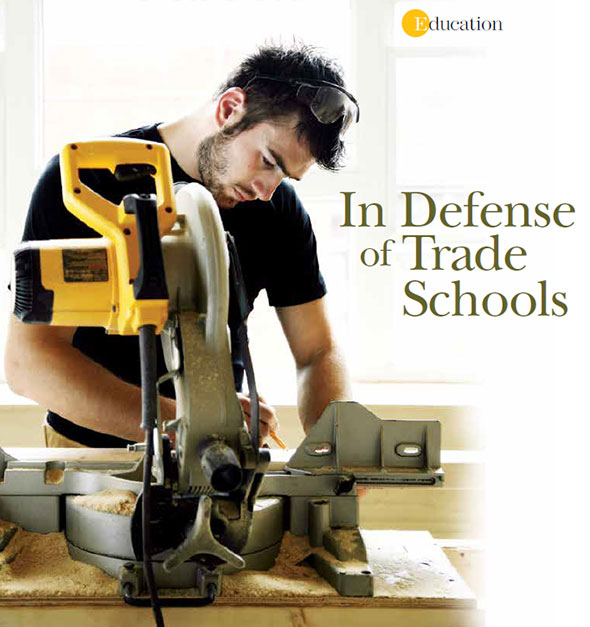
Now that technology is easily accessible for most sectors of society, our culture has come to see vocational education as obsolete—why bother working with your hands when you have a computer? Many people feel that the Internet is a powerful source of information and therefore there is no need for skills that don’t involve typing 80 words per minute. “As a society, we dismissed the manual arts as a relic of the past,” says Ryan Blythe, executive director of the Georgia Trade School. “For a generation or two, computers and college degrees were seen as the path to advancement. It is as if we forgot that certain jobs could not be performed in a cubicle by an office worker.” The common viewpoint is that most skilled labor jobs are limiting in terms of career advancement and financial security and generally low-paying. “While there is a misconception that skilled labor jobs are low-paying, the truth is that these are positions that offer job security and salaries that rival most professions,” says Rebecca Long, public relations specialist for Chattahoochee Technical College.
It doesn’t help trade schools that the standard American high school curriculum is strongly college preparatory. The fact remains that some essential jobs can never be done from behind a desk. Our country will always need the expertise of trained plumbers, electricians, mechanics and truck drivers, making it highly unlikely these jobs will ever be outsourced. Trade schools provide a valuable service in helping students prepare for these careers.
An Alternative to College
In this day and age, the traditional advice to high school graduates to just go to college doesn’t always pay off. That’s not to say that a college education is no longer worth it, but times have changed. Having a degree does not necessarily guarantee you a job or a middle-class wage. This is exacerbated by the rising cost of schooling—according to higherducation.org, Georgia, Louisiana and Florida all saw 2–5 percent increases in four-year college tuition between 2001 and 2003, while Southern states such as Mississippi, Tennessee and Alabama saw a 6–10 percent increase for the same timeframe. “College is not for everyone, and there is no doubt in my mind that we send far too many high school graduates to a four-year university,” says Blythe. “The statistics back this up, with the average college graduate swimming in $25,000 worth of student debt and half of the 2011 grads still living at home.”
Experts say that the U.S. will soon be staring at a major shortage of skilled workers. As the older generations age and retire, employers will find that there are very few qualified job seekers to fill their positions. “With an aging workforce and growing skills gap, we are seeing a high demand for people with these skills,” says Long. “According to some statistics I have seen, for every four people in a skilled trade who decide to retire, there is only one qualified applicant for those four open positions.” For the welding field alone, our nation is expected to need an additional 238,000 workers by 2019 just to keep up.
Filling the Gap
Against this backdrop, trade schools have experienced something of a renaissance. Young people and non-traditional students, some of whom have already earned a four-year degree, are again seeing the value of skilled labor and trades with the help of government initiatives to encourage growth in the trades. In January, Governor Nathan Deal announced the launch of a statewide workforce development initiative called Go Build Georgia. Go Build Georgia piggybacks off the success of Go Build Alabama, which was initiated in 2010 by Alabama’s Construction Recruitment Institute as a trial before extending the program to other states. The program, which is endorsed by Mike Rowe of “Dirty Jobs” fame, aims to educate young people about the value of learning a trade and inspire them to consider taking up a career in the field. If successful, the project will spur future economic growth and improve the marketability of Georgia’s workforce. In addition, the popularity of television shows featuring the work of skilled tradesmen such as “Extreme 4×4,” “Two Guys Garage” and “Modern Marvels” have made the career path even more attractive to a younger generation.
Of course, the current state of the economy also has something to do with the resurgence. “A large contributing factor to increased and maintained enrollment is the uncertainty in the economy,” says Long. “We saw an influx of students wanting to start a new career, expand skills in a current field, or even get a head start on a four-year degree by completing general education courses at a lower cost and closer to home.” Chattahoochee Technical College experienced a double-digit increase in enrollment from 2009 to 2012. The numbers remain around 11,500 for the fall 2012 semester.
Looking Forward
In order for the future workforce to flourish in today’s economy, there must be options. Schools could benefit from embracing different forms of education and understanding that providing just a single track will not work for every student. “It completely depends on the individual,” says Blythe. “College will remain an important part of our country as many professional positions will require a degree or advanced degrees.” It is important that trade schools coexist with other types of higher education to ensure a secure future for all students.
The future of skilled labor looks very bright, according to current statistics. The Chronicle on Higher Education states that hiring for new associate degree recipients is expected to grow by more than 30 percent in the coming year. Students in welding programs are finding opportunities upon completion of their training programs. “We offer students a 30-hour unpaid internship. However with the current demand many students will be going directly to work,” says Blythe. Another positive: “In areas such as commercial truck driving we are seeing graduates with multiple offers because the need is so great,” says Long.
















